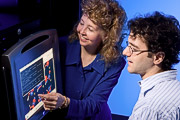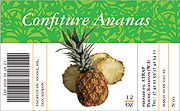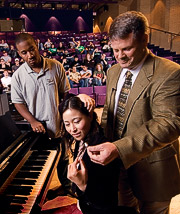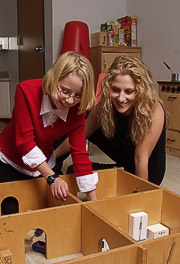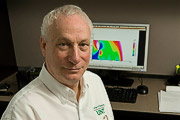 |
|||||||||||||||||

Bright Solutions
|
Only 10 percent of the energy a light bulb uses actually creates light, which means valuable natural resources are wasted. Scientists are collaborating to create a more perfect — and efficient — white light. Consumers in impoverished Haiti consistently bypassed locally grown produce for products from as far away as China. A design expert worked with farmers to produce sleeker, more professional labels, which immediately increased sales. The United States' 911 services have not kept pace with technology such as text messages and Internet-based phones. A computer science researcher is leading a prestigious multi-university team in the first major update of the country's emergency services since the 1970s. Researchers at UNT are searching for — and finding — solutions to some of today's most pressing needs. They are finding ways to preserve the Earth's natural resources. They are helping poor communities. They are searching for ways to create a safer world. "Our faculty members are some of today's brightest minds, and they truly are working to provide solutions for some of today's biggest challenges," President Gretchen M. Bataille says. "We are providing a rich environment that nurtures artistic expression, encourages community service, embraces the humanities and social sciences, and allows our faculty to add to our nation's knowledge base through cutting-edge research.
"Our research is leading to solutions for real-world issues." To ensure UNT has the resources necessary to expand its research profile, the university pledged this fall to invest at least $25 million in collaborative research in an effort to strengthen the state's economy and expand the innovative research already happening at UNT. The university will hire nationally and internationally renowned experts to build upon its reputation in six key fields: bio/nano photonics, materials modeling, developmental physiology and genetics, plant sciences, autism and technology in art. Military outcomes Some of the research on campus will make military actions safer, and some may actually predict the outcome before any action is taken.
The Institute for Science and Engineering Simulation, UNT's newest research center, is dedicated to studying the causes of jet engine failure so that stronger, more durable engines can be developed. In October, federal legislators and university officials announced UNT would receive about $8.5 million from the U.S. Air Force Research Laboratory in Ohio over the next two to three years to create its new center. With direction from the Air Force, faculty researchers from materials science and engineering and chemistry will use modeling, simulation and experimentation to study the performance of aircraft materials. "With wars in Iraq and Afghanistan, a great deal of stress is being placed on the country's aircraft," says Rajarshi Banerjee, the director of ISES and associate professor of materials science and engineering. "The research at UNT will help maintain and extend the life of aging aircraft, prevent catastrophic engine failure and aid the Air Force in developing better materials for the next generation of aircraft." Meanwhile, Michael Greig, assistant professor of political science, and Andrew Enterline, associate professor of political science, are working to predict the outcomes of possible future military actions. They have compiled and studied 172 U.S. military clashes from 1945 to 2002 and used that data to create a model to predict outcomes in Iran. Military clashes ranged from minor (the United States scolding Canada for a fishing dispute in the Northwest) to major (the first Iraq war). To project outcomes, they evaluate several factors, from the kind of military action to the country's education level, economic prosperity and size. "Our aim is to do work that will be of interest to policymakers," says Greig, who is working to publish a paper on their Iran predictions. Their first paper on Iraq, "Beacons of Hope? The Impact of Imposed Democracy on Regional Peace, Democracy and Prosperity," was published in 2005 in the Journal of Politics. "We're trying to make academic work helpful in answering some contemporary political questions." Emergency services Another faculty member is working to make the nation's emergency services more reliable.
Ram Dantu, associate professor of computer science and engineering, is pioneering research that will overhaul the 911 infrastructure to better handle emerging technology such as Internet-based phones, text messages and phones with photo capabilities. Dantu's projects have received more than $3 million in funding from the National Science Foundation. Driven by lower costs, more than 24 million people in the United States have switched to Voice-over Internet Protocol, or VoIP as it is commonly called, for their phone service. Within the next decade, Dantu says VoIP is likely to replace the traditional telephone system, which connects callers through wire lines. That could be a problem for 911 centers, however, because VoIP is tied to an Internet address rather than a physical location. For example, an Internet user with a Denton address may call 911 from his or her laptop but physically be somewhere else. Tracking that person is a challenge. "This issue affects everyone," Dantu says. "When you call 911, responders must be able to find you." That reality was illustrated earlier this year when a toddler in Canada died after his parents used VoIP to call 911 but the call was routed to the wrong 911 center. To address the issue, Dantu is creating a 911 testbed for future research and experimentation of next-generation 911 services. Leading a team of researchers from Columbia University and Texas A&M University, he is searching for a low-cost and practical way to track callers. "The way we communicate will change greatly in the next five years," Dantu says. "It is vital that our emergency services be prepared for those changes." A cleaner environment
For example, Mohammad Omary, associate professor of chemistry, is leading a team of faculty and students from chemistry and materials science and engineering in designing new lighting sources that are eco-friendly yet affordable, long-lasting and safe, simple in structure yet brilliant white in color. With nearly $2.3 million from the U.S. Department of Energy, the team is pioneering innovative research in the field of organic light-emitting diodes, or OLEDs, an emerging technology that scientists say could revolutionize lighting. The technology’s importance is clear. Lighting consumes nearly one-quarter of all electricity produced in the United States. OLEDs require far less energy to produce and operate than incandescent lights, which would lead to billions of dollars in savings and enormous reductions in carbon emissions. “We know we are in a global energy crisis,” Omary says. “Getting rid of old light bulbs and adopting alternative sources of light is one of the most significant ways we can reduce our energy consumption.” To do this, the researchers synthesize new metal-organic materials by mixing organic materials (containing carbon, hydrogen and nitrogen) with precursors of metals like gold, platinum or copper. The solid materials are capable of producing bright phosphorescence, or long-lived light emission. The materials are then sent to Nigel Shepherd, an assistant professor of materials science and engineering, for design and construction of the light-emitting devices. While the UNT team is focused primarily on white lights — those used for standard room lighting — the technology has applications in display lighting, such as television and computer screens, cell phones and alarm clocks.
In another lab, Angela Wilson, an associate professor of chemistry, is leading a team of researchers in UNT’s nationally recognized Center for Advanced Scientific Computing and Modeling to explore what happens when greenhouse gases are stored underground. Each year, about seven billion tons of man-made carbon dioxide escape into the Earth’s atmosphere, contributing to global warming, scientists say. Underground storage of the gases has emerged in recent years as a potential solution. “Policymakers are going to have to make some very big decisions in the next decade on global warming,” says Tom Cundari, Regents Professor of chemistry and one of the lead investigators. “We’re going to use computers to act like a time machine and speed up those chemical reactions to determine how the CO2 will react with water and minerals underground.” The project is funded by the U.S. Department of Energy. It allows researchers to use computer modeling and simulation to study the physical and chemical changes that the presence of CO2 could cause to the geological formations in which it is stored. Art education The arts have been a cornerstone of UNT's education for decades. And while the university is training the next generation of artists and musicians to produce masterpieces, it is also encouraging faculty to seek ways art can serve, heal and better the community. Nada Shabout, an associate professor of art history and a Fulbright Scholar, is preserving contemporary Iraqi art through her efforts. She is working to document artwork missing or stolen from the Iraqi Museum of Modern Art in Baghdad. The museum was damaged by fire and looting after bombings in 2003.
In another area of the world, Keith Owens, assistant professor of communication design, has proven invaluable to Haitian farmers trying to understand why shoppers were passing up local products and purchasing those shipped from places far away. After surveying shoppers, Owens found that the scribbled labels on the Haitian products were turning people away. They assumed the more professional labels meant better produce. Since then, he has traveled to Haiti twice to work with local farmers on producing professional food labels. The impact was immediate. In test markets, sales increased for Haitian products. "Haiti is a desperately poor country —† few TVs or radios, almost no Internet," says Owens, who has spent the last six years studying how design can effect positive social change in the world. "Consumers make their purchasing decisions based on what they see in the store because they do not have advertising to sway them."
Another faculty member, Kris Chesky ('88 M.M.E., '92 Ph.D.), director of education and research at UNT's Texas Center for Music and Medicine, is educating student musicians about the link between playing musical instruments and noise-induced hearing loss. By doing so, he hopes to help musicians keep what is perhaps their most important asset — the ability to hear. Happier, healthier children Through the years, UNT faculty members have been at the forefront of much groundbreaking, nationally recognized research to ensure the nation's youngest citizens are well adjusted. One success story is the research of the Child and Family Resource Clinic and the Center for Play Therapy, which is the largest play therapy training facility in the world and serves as a model for universities worldwide that are establishing similar centers. Both use play to help children express their feelings.
Researchers currently are trying to determine if there is a link between play therapy and academic achievement. In the past, they have shown play therapy has a positive effect on student-teacher relationships and positive results for children with Attention Deficit Hyperactivity Disorder and those who exhibit aggressive behavior. "When children are allowed to play freely, they're in an environment where they're accepted and understood," says Dee Ray ('98 Ph.D.), director of the Child and Family Resource Clinic and an associate professor of counseling. "They're able to show how they feel through their actions, not words." These efforts aren't the only ones focused on helping children thrive. UNT researchers also are conducting applied autism research, such as education, behavior analysis and learning technologies. The disorder affects 1 percent of children, about 800,000, each year in the United States alone. This spring, Demetria Ennis-Cole, associate professor of learning technologies, and Cathleen Norris ('83 Ph.D.), Regents Professor of learning technologies, plan to open the Technology and Applied Research in Autism laboratory to study and help parents and caretakers use technology to improve social skills and academic development of children with autism. The struggles of Ennis-Cole's 9-year-old son who has autism prompted her interest in the developmental disability, and TARA will build upon her body of autism research. TARA will provide families with various kinds of technology, such as instructional software, computer games, video modeling, reading devices and flash cards, and researchers will study the tools' effectiveness. Ennis-Cole says she focuses on improving the quality of life for those affected by autism or related disorders. "We want to figure out which technologies work and which ones don't work, and then disseminate that knowledge," she says. "As we do that, we'll help families connect with real solutions that make life a little easier and a lot more rewarding." A bright future The work of Ennis-Cole, Dantu, Omary and many others is key to ensuring a better future for our global society. Recent university efforts will extend the reach of UNT faculty and their research, Bataille says.
"UNT was founded in 1890 as a teacher training school that over time grew into a broad-based research university," she says. "Today, its excellence in education, music and the arts and humanities is complemented by a growing stature in science and technology." The momentum on campus is evident — even to some of UNT's newest faculty members, such as Alan Needleman, a visiting professor of materials science and engineering at UNT since 2007. A longtime faculty member at Brown University, Needleman will join UNT full time next fall and will be heavily involved with ISES. "I like the people and the atmosphere here," says Needleman, who is a member of the National Academy of Engineering and was elected last year to the prestigious American Academy of Arts and Sciences. "UNT is full of exciting possibilities." Learn more about research at UNT in UNT Research magazine. |
||||||||||||||||||||||||||||||||||||||||||||||||||||||||||||||||||||||||||||||||||||||||||||||||||||
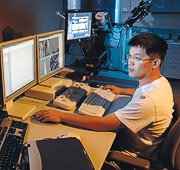

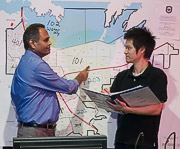
 Numerous other researchers are working to use natural resources more efficiently and clean the Earth’s atmosphere, making the world a healthier place.
Numerous other researchers are working to use natural resources more efficiently and clean the Earth’s atmosphere, making the world a healthier place.
